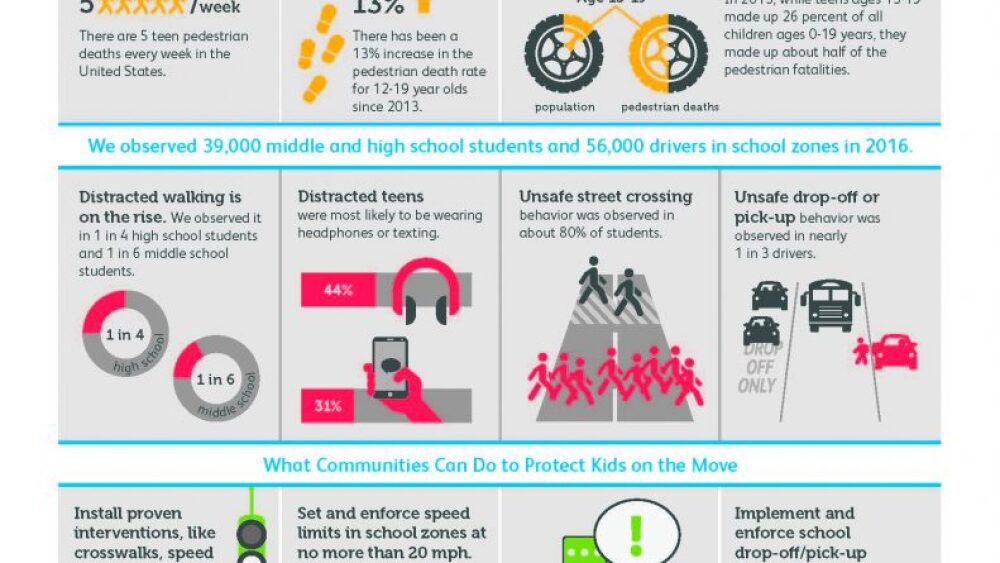A new report released from Safe Kids Worldwide, made possible with support from FedEx®, reveals that school zones can be unsafe places for students. The research observed 39,000 walkers and 56,000 drivers in school zones and recorded risky behaviors, including distracted walking by students, distracted driving by those dropping off, unsafe speed limits, unmarked crosswalks and limited crossing guards.
This comes at a time when, according to data from NHTSA, pedestrian deaths among 12 – 19 year olds have increased 13 percent in the past two years. In fact, 5 teens die every week while walking. And in the past three years, distracted walking has increased from 1 in 5 to more than 1 in 4 for high school students and from 1 in 8 to 1 in 6 for middle school students.
Safe Kids Worldwide is calling on communities to make safe school zones a priority by lowering and enforcing speed limits of no more than 20 mph, installing signs and crosswalks where needed, enforcing smart policies for dropping off and picking up students, and putting an end to distraction while driving and crossing the street.
The research, “Alarming Dangers in School Zones,” is an observational study that recorded middle and high school students crossing the street in a school zone. About 80 percent of students were observed crossing the street in an unsafe manner. Teens who were distracted were most likely to be wearing headphones (44 percent) or texting (31 percent).
In addition to observing walkers, the study also recorded how drivers behaved during drop off and pick up. Nearly 1 in 3 drivers displayed unsafe behaviors that endangered pedestrians, like texting, double parking or blocking a crosswalk.
Low speed limits (at or below 20 miles per hour) were observed in only 4 out of 10 school zones. And marked crosswalks were missing in 3 out of 10 crossings.
Interventions can work, but only if they are enforced. Researchers observed that drivers were far less likely to engage in unsafe behavior at schools where a drop-off/pick-up policy was enforced compared to schools where the policy was not enforced.
“With teen pedestrian deaths on the rise, we need to rally our communities to take action to protect our kids,” said Kate Carr, president and CEO of Safe Kids Worldwide. “Let’s commit to slow down to at least 20 miles per hour in school zones, enforce the rules and put an end to distraction while driving and crossing the street.”
“This new research draws attention to a problem that all of us can work to solve,” said Rose Flenorl, manager, FedEx Global Citizenship. “FedEx is committed to helping advance road safety best practices across the U.S. and around the world.”
Safe Kids Worldwide and FedEx are working to protect kids on the move.
Communities can:
- Identify high risk school zones and pursue proven interventions, like crosswalks, appropriate speed limits, visible signs, crossing guards and traffic lights.
- Educate parents and students about dangerous walking and driving habits (e.g., not crossing mid-block and avoiding distractions such as texting or talking on the phone).
- Set and enforce speed limits in school zones at no more than 20 miles per hour.
- Implement and enforce school policies regarding drop off and pick up of students.
To take action, reach out to your school officials and local elected officials. For more information, visit safekids.org.
